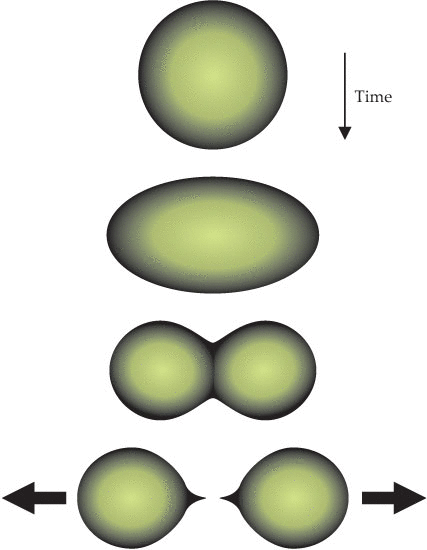Spontaneous fission atomic nucleus is a process by which the nucleons that build the nucleus divide spontaneously, forming two lighter nuclei. This instability of heavy atomic nuclei is a consequence of one of the fundamental laws of nature – it allows the nucleon system to be transformed into a state of minimal energy. Research (experimental and theoretical) on the phenomenon of fission has been carried out continuously since the first observation of this phenomenon (1938). Still many aspects of the process remain research challenges. The development of a theoretical model that consistently and accurately reproduces measurable characteristics of spontaneous fission is particularly important in the context of its predictive power in areas not accessible experimentally. These areas include the phenomenon of stellar nucleosynthesis, a detailed description of which would explain the abundance of heavy elements in the solar system.
In this project it is postulated that a detailed description of the fission phenomenon can be obtained with the use of tools appropriate for the description of the micro world – quantum mechanics. The state of the nucleus is described by the wave function which is the sum of the functions of the nucleons that build the nucleus. A properly defined wave function contains full information about the studied isotope, both in its ground state and at every stage of its deformation leading to fission. Using the basic tools provided by quantum mechanics, it is possible to track how the shape of the nucleus evolves, and to determine the probability with which the nucleus will take a particular shape before fission. It is assumed that the revision and modification of certain assumptions of the existing microscopic models of the nucleus description will allow a deeper understanding of the fission process, and thus improve the accuracy in reproduction of the available values measured in experiments.
Traditionally, the fission process is described in terms of the evolution of the nucleus shape from the ground state, in which the nucleus is usually spherical, to the deformation preceding rupture, when the nucleus takes a molecular shape with a distinct constriction. The dependence of the potential energy of the nucleus corresponding to a specific deformation is then obtained by solving the equations taking into account various parameters describing „geometrically” deformation of the nucleus. In this project it is postulated that these equations should be solved taking into account, apart from the variables directly related to deformation, also other degrees of freedom related to the internal structure of the nucleus and the correlations between the nucleons.

As part of the project, it is planned to carry out calculations taking into account the above-mentioned assumptions for a representative group of isotopes. It is assumed that in this way it is possible to recreate with satisfactory accuracy the essential characteristics of the fission phenomenon: the mass distribution of the fission fragments and the half-life. The choice of these two characteristics is related to the fact that they are measurable in experiments, so it will be possible to compare the obtained theoretical results with the experimental ones in order to verify the correctness of the made assumptions.
Half-life is the time until half of the original number of nuclei in the sample, unstable due to spontaneous fission, remain. It is a quantity that characterizes a given radioactive isotope, regardless of external factors such as temperature, pressure or its chemical form.
The second studied characteristic is the distribution of masses of products resulting from the fission of the parent nucleus. Series of measurements of the masses of the fission products from a sample of a fissile isotope allows one to record the number of times a given nucleon division has taken place. Plotting the results of such an experiment on the graph creates a distribution of the masses of the fission fragments, which is a graphical representation of the statistical nature of the phenomenon (fig. on the right; A-number of nucleons of the fission product). The mass distribution of fission fragments is thus something like an isotope’s „fingerprint”, one of the basic characteristics of the nucleus, and its shape allows indirect inference about the structure of the parent isotope. The observed mass distributions indicate the complexity of the fission process. The development of a complete theoretical description allowing the reproduction of experimental data would be an important step in understanding the mechanisms governing the division of nucleons between fragments.
It is expected that the results of the calculations based on the made assumptions will allow to reproduce the measured values of the above fission characteristics with a high accuracy,and will be a step forward in deepen our knowledge about the fission process. This will be useful when planning reactions leading to the production of new super-heavy nuclei. It will also allow for better management of radioactive waste from nuclear power plants.
